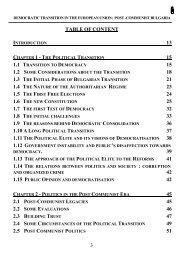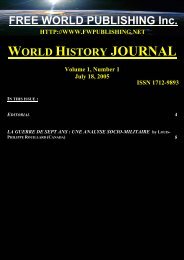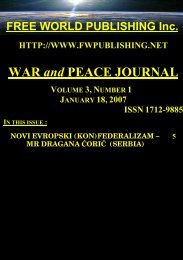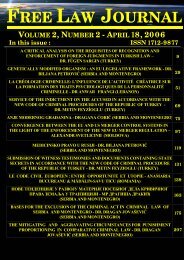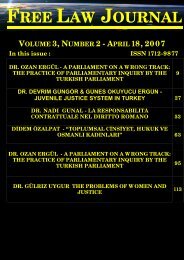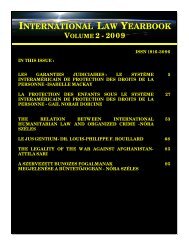Free_Law_Journal-Vol.. - Free World Publishing Inc.
Free_Law_Journal-Vol.. - Free World Publishing Inc.
Free_Law_Journal-Vol.. - Free World Publishing Inc.
Create successful ePaper yourself
Turn your PDF publications into a flip-book with our unique Google optimized e-Paper software.
FREE LAW JOURNAL - VOLUME 1, NUMBER 1 (18 JULY 2005)<br />
judgement is put forward. Otherwise, res iudicata alii non nocet principle which means that judgement of<br />
the court must not harm people who are not the party of the action, is put into practice 35 .<br />
Sameness of the parties (Subjective similarity);<br />
As a rule, the judgement given at the end of the action, binds and shows its effects only on the parties of<br />
the action (res iudicata ius facit inter partes). For example, only the plaintiff can not bring an action of<br />
replevin (rei vindicatio) once again, if he is identified as not owing the land. Of course, the sentence of the<br />
court also binds the successors of the plaintiff and defendant 36 . In fact, sameness of the parties is<br />
considered as a legal position than an actual position. For this reason, the exception of definite judgement<br />
can be brought forward to the successors of the plaintiff and defendant, but it does not affect<br />
predecessors 37 . But a person who brings an action as a trustee, does not encourter any legal obstacles if he<br />
brings the same action again, but this time as a plaintiff 38 .<br />
Sameness of the subject (Objective similarity); The contentious issue must not be the subject of another<br />
action. That is, every intentio section of an action’s formula must be different from each other. Otherwise,<br />
bis de eadem re ne sit actio principle is violated because, the subsequent action can not be brought before<br />
the court with reference to same contentious issue 39 . When two or more actions have different formulas 40<br />
but they head for the same aim, they may be considered as same actions 41 , if they fulfil other necessary<br />
conditions.<br />
In real actions, the reason of the action has great importance. In this kind of actions, the plaintiff does not<br />
have to prove how he obtained the right 42 . If the plaintiff brings an action, claiming that he ownes the<br />
subject of the action becuse it is transferred to him by tradito and he loses the action of replein (rei<br />
vindicatio), because he can not prove his claims, then it becomes impossible for him to bring another<br />
action of replein, this time claiming that he ownes the contentious issue by acquisition of quiritary<br />
ownership over a corporeal thing (usucapio) 43 . The defendant has the right to bring forward the exception<br />
of definite judgment in this second action 44 . But in the progressive period of Roman law, this proceeding<br />
is changed. It is still accepted that real actions bar all future real actions on possible reasons of the claim.<br />
35 Colquhoun, P., Summary of the Roman Civil <strong>Law</strong>, London, 1849, p. 595; Marzo, di S.; Roma Hukuku, 6. Ed., Transl. by Z.<br />
Umur, Istanbul, 1961, p. 127, 132, 147; Tahiroglu/Erdogmus, (Matters), p. 196.<br />
36 D. 44, 2, 4; D. 44, 2, 28.<br />
37 Buckland, p. 699; Sameness of the parties means juristic identity.<br />
38 D. 44, 2, 4, 9 ; Tahiroglu/ Erdogmus, (Matters), p. 196.<br />
39 Tahiroglu/ Erdoğmuş, (Matters), p. 197; Wenger, p. 190.<br />
40 Buckland, p. 697; For instance an action in factum on a deposit contract bars an action in ius on the same facts. This rule is<br />
also valid for different contracts.<br />
41 D. 44, 2, 3.<br />
42 Pugliese, (Processo), p. 287; As an example, in an action of replein, it is sufficient for the plaintiff to prove that he ownes the<br />
contentious thing.<br />
43 Buckland, p. 241 sq.; Usucapio can be defined shortly as acquisition of dominium by possession for a certain time.<br />
44 Provera, p. 68; This solution which is used in real actions is considered to belong to the Roman classical law period. In<br />
classical law period, if the reason of the action is shown in the intentio phase of the real action’s formula, the plaintiff, after<br />
being cast in this real action, does not have the right to bring the same real action. And this result does not change, even if he<br />
bases on a different reason, in second action. There can be found some texts in Roman law sources, which defend the opposite<br />
opinion. But they are claimed as interpolated. Buckland, p. 696; In real actions the bar is only praetorian. We can say that in<br />
these actions in the legis actio procedure, no bar exists, because lex Aebutia does not allow the formula in real actions. But this<br />
conclusion is not generally accepted by Roman jurists. As in legis actio procedure, joinder of issue is at its beginging and the<br />
baring effect can not bear any relation to novatory effect. This is due to the bis de eadem re ne sit actio principle.<br />
GOKCE TURKOGLU-OZDEMIR - “BIS DE EADEM RE NE SIT ACTIO” PRINCIPLE IN THE FORMULARY SYSTEM OF ROMAN LAW OF PROCEDURE 146






